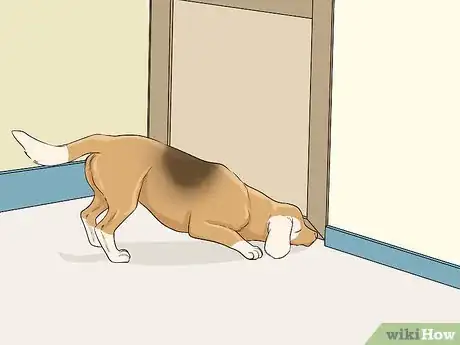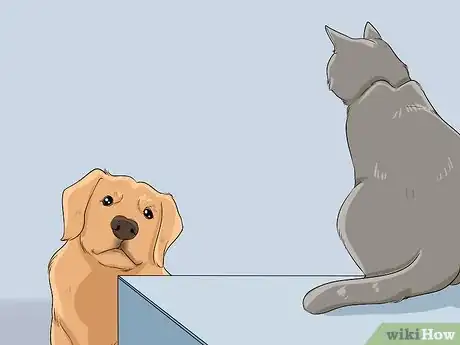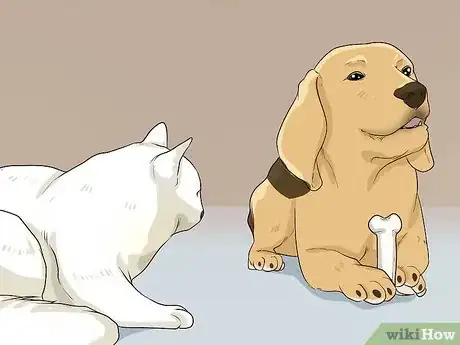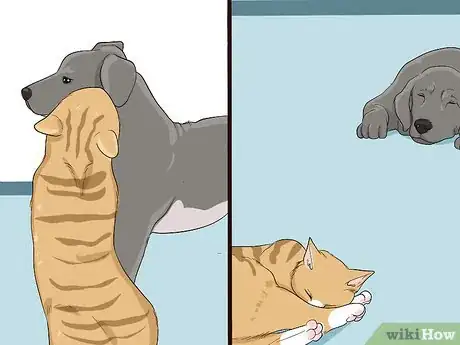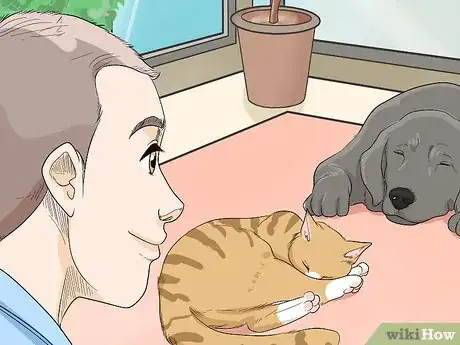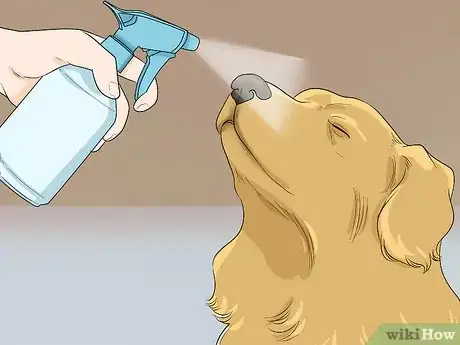This article was co-authored by Melissa Nelson, DVM, PhD. Dr. Nelson is a Veterinarian who specializes in Companion and Large Animal Medicine in Minnesota, where she has over 18 years of experience as a veterinarian in a rural clinic. She received her Doctor of Veterinary Medicine from the University of Minnesota in 1998.
There are 7 references cited in this article, which can be found at the bottom of the page.
This article has been viewed 64,835 times.
Getting a new pet can be such an exciting and fun experience, but if you already have another pet at home, you’ll need to take some precautions. Move slowly with the introductions by keeping the dog in a crate at first, then later on a leash, while the cat roams free. It may take a few hours or even a few months for the cat and dog to get used to each other, but it’ll be worth it when the process is complete!
Steps
Letting the Animals Smell Each Other
-
1Keep the animals in separate rooms for the first few days. You want to start the process slowly by keeping the dog and the cat in separate areas. If both animals are indoor-only, you might want to consider locking the cat in a bedroom for a couple of days while everyone adjusts to the change.[1]
- If you separate the cat in a bedroom, make sure you put everything it will need in there too – like food, water, litterbox, and some toys.
- When you first bring the cat into the house, it's best to have the dog either locked away or out of the home. This way the dog won't jump around the pet carrier and scare the cat as you bring it into the home for the first time.
-
2Touch one animal, then let the other smell the scent on you. Let the animals get used to each other’s scent before actually introducing them. Pet one of the animals individually, then, without changing clothes, go to the other animal and let it sniff the scent. Do this for each animal so that they can grow accustomed to the scent of the other animal before a real face-to-face encounter.[2]
- It’s best if you can keep swapping the scent for a few days, or until the dog and cat stop acting so interested in the new smell.
Advertisement -
3Let the animals smell each other underneath the door. Once both animals have become accustomed to the others’ scents, let them interact from opposite sides of a door. Bring your dog to the outside of the door to the cat’s room and let them sniff each other from underneath the door.[3]
- If the dog gets too wild or starts digging at the door barrier, you should remove the dog and try again another time when it has calmed down.
- Don’t move forward to a face-to-face encounter until both animals can smell each other under the door without getting agitated.
Allowing Face-to-Face Interactions
-
1Let your cat be in charge of how much it interacts with the dog. During the entire process, you should never force the cat to interact with the dog. Give your cat a way to escape (something high to jump on) and keep the dog at a distance.
- If the cat doesn’t seem interested in engaging with the dog right away, don’t force it. Wait a while and let your cat approach the dog on its own.
- Don’t force the cat to interact with the dog, no matter how long it takes. Keep making slow progress until the cat feels comfortable enough to approach the dog on its own, even if this process takes weeks.
- Make sure the cat's front claws are trimmed, and monitor the pets while they're together. Until you're sure they get along peacefully, pay careful attention to where the cat is in relation to the dog. Make sure the cat cannot scratch the dog's face.
-
2Keep the dog in its crate and let the cat roam free for the first few encounters. With the cat in the other room, put your dog in its kennel and lock the door. Then let the cat out and encourage it to follow you into the room with the dog. The cat should eventually get curious about the dog and come close enough to smell the other animal.[4]
- If your dog goes crazy when it sees the cat, try to calm it down using a soothing voice. Encourage the dog to remain calm and use positive reinforcement by giving it treats when it acts the way you want it to.
- If treats and soothing reassurances aren’t enough to calm your dog down, remove the cat and revert back to the smelling under the door step until the dog is better able to control its excitement.
-
3Keep your dog leashed and let the cat roam free once they have adjusted to the kennel step. Let the dog out of its crate, but keep it firmly controlled on a leash. The cat should be allowed to roam free so that it feels comfortable and able to retreat if necessary. Allow the animals to sniff each other. If the cat reacts poorly by hissing or hiding, this isn’t unusual. Try to let the animals interact for a couple of minutes, but put the cat back in its separate room if it seems too anxious or upset.[5]
- Always keep the dog on a leash (or at least hold it firmly by the collar) to control how close the dog can get to the cat.
- If your dog jerks at the leash or lunges for the cat, go back to the previous step and put the dog back in its crate.
-
4Try distracting your dog with treats to teach it to ignore the cat. A great way to train your dog to leave the cat alone is to teach the dog that it is more rewarding to not look at the cat through positive reinforcement with treats. When the animals are in the same room, try giving your dog a verbal cue (by using a clicker, or saying a word like “good”) to draw the dog’s attention. Then give the dog a treat.[6]
- This will teach the dog that there are positive consequences for ignoring the cat and looking at you instead.
- Do this several times throughout each day until the dog loses interest in the cat and focuses on the positive reinforcement treats with no trouble.
-
5Keep the initial interactions to a minimum. It can be quite stressful for both cats and dogs to meet new animals. Try to keep the first few introductions quite short to avoid overloading your pets. Let them see and sniff each other for a few minutes, then separate the animals again.[7]
- You don’t want to create a negative association for either of the animals, so don’t force them to do anything they don’t want to do.
- A good rule of thumb is that the animals are ready to take the next step when they stop acting upset/overly interested in the current level of interaction.
- For example, once your pets don’t act interested when they smell each other under the door, it’s time to move to the kennel step. When they don’t get upset being in the same room while the dog is in its crate, and the cat roams freely around, it’s time to move to the leash step.
Taking the Proper Precautions
-
1Watch both animals’ body language. During interactions, make sure you monitor both the dog and the cat to make sure they are doing okay. It’s normal for them to be excited, or even a little bit upset, but you don’t want the animals to get too stressed out.[8]
- Some signs that your cat has had enough include pinned back ears, swishing tail back and forth, and growling sounds.
- If your dog stiffens, stares motionlessly at the cat, or starts barking uncontrollably, it might be time to separate the animals for the moment.
-
2Monitor your cat’s litterbox habits. You should watch your cat’s litterbox for signs about how the introduction is going. If the cat is using the litterbox normally, then it is probably relatively happy and feeling secure with the situation. If your cat is defecating outside the litterbox, it’s quite possible that the stress of the new dog may be causing it. In this case, you’ll need to slow down the introduction process.[9]
- Normal litterbox behavior means that your cat should be using the litterbox several times each day, with no accidents outside the box.
- Make sure that the dog cannot get into the cat's litterbox. It should also not be able to trap the cat in the litterbox area.
-
3Use positive reinforcement. You want to make the introduction experience as pleasant as possible so that both animals will associate the new pet with something happy or enjoyable. Try to give the cat and the dog treats during the introduction process, especially if they are behaving calmly.[10]
- You should also use a soothing voice and stroke the cat during the introductions. Another person should do the same to the dog. This will also help to create a positive association with the other animal.
-
4Use a baby gate to give the cat an escape option. You might want to consider using a baby gate to partition off part of the house. This way, the cat can jump over the gate and go relax in parts of the house that are inaccessible to the dog.
- At the very least, make sure there are some tables, counters, or high shelves that your cat can jump on to escape from the dog if necessary.
- This will allow both animals to have the space they need as well as giving your cat the freedom to choose how much or how little it interacts with the dog.
-
5Spray the dog with water if it refuses to get along with the cat. Spraying the dog with water is a counter conditioning strategy that will help the dog learn that being mean to the cat is not allowed. When the dog misbehaves, simply spray it with water. Over time, it will start to avoid those behaviors.
- For example, spray the dog if it nips at the cat.
- Alternatively, you could use a halti or gentle leader collar or a behavior correcting collar.
Expert Q&A
-
QuestionWhat dog breeds are good with cats?
 Melissa Nelson, DVM, PhDDr. Nelson is a Veterinarian who specializes in Companion and Large Animal Medicine in Minnesota, where she has over 18 years of experience as a veterinarian in a rural clinic. She received her Doctor of Veterinary Medicine from the University of Minnesota in 1998.
Melissa Nelson, DVM, PhDDr. Nelson is a Veterinarian who specializes in Companion and Large Animal Medicine in Minnesota, where she has over 18 years of experience as a veterinarian in a rural clinic. She received her Doctor of Veterinary Medicine from the University of Minnesota in 1998.
Veterinarian It really depends on the individual dog, however, dogs with high prey drive are generally not compatible with cats.
It really depends on the individual dog, however, dogs with high prey drive are generally not compatible with cats. -
QuestionHow do you introduce a kitten to a dog?
 Melissa Nelson, DVM, PhDDr. Nelson is a Veterinarian who specializes in Companion and Large Animal Medicine in Minnesota, where she has over 18 years of experience as a veterinarian in a rural clinic. She received her Doctor of Veterinary Medicine from the University of Minnesota in 1998.
Melissa Nelson, DVM, PhDDr. Nelson is a Veterinarian who specializes in Companion and Large Animal Medicine in Minnesota, where she has over 18 years of experience as a veterinarian in a rural clinic. She received her Doctor of Veterinary Medicine from the University of Minnesota in 1998.
Veterinarian Slowly and carefully. Put the kitten into a room with all its supplies and close the door. Allow the dog to sniff at the door bottom. Play with the kitten in this room and let it get comfortable with its new home for a few days before bringing the dog (on a leash) into the room to meet the kitten.
Slowly and carefully. Put the kitten into a room with all its supplies and close the door. Allow the dog to sniff at the door bottom. Play with the kitten in this room and let it get comfortable with its new home for a few days before bringing the dog (on a leash) into the room to meet the kitten. -
QuestionWhat is the best way to introduce a cat and a dog?
 Melissa Nelson, DVM, PhDDr. Nelson is a Veterinarian who specializes in Companion and Large Animal Medicine in Minnesota, where she has over 18 years of experience as a veterinarian in a rural clinic. She received her Doctor of Veterinary Medicine from the University of Minnesota in 1998.
Melissa Nelson, DVM, PhDDr. Nelson is a Veterinarian who specializes in Companion and Large Animal Medicine in Minnesota, where she has over 18 years of experience as a veterinarian in a rural clinic. She received her Doctor of Veterinary Medicine from the University of Minnesota in 1998.
Veterinarian Place the new animal in its own room with a closed door and allow the resident animal to sniff along the door. Let the new animal get acclimated to this room over a number of days before allowing the resident animal into the room for closely supervised introduction.
Place the new animal in its own room with a closed door and allow the resident animal to sniff along the door. Let the new animal get acclimated to this room over a number of days before allowing the resident animal into the room for closely supervised introduction.
Warnings
- If either animal shows signs of aggression, remove them from the situation immediately and start the introduction process over again – beginning with swapping scents, then moving to smelling each other under the door, then put the dog in the kennel, etc.⧼thumbs_response⧽
References
- ↑ https://bestfriends.org/resources/how-introduce-dog-cat
- ↑ https://www.paws.org/library/cats/home-life/introducing-cat-to-dog/
- ↑ https://www.adoptapet.com/blog/6-steps-to-introduce-a-new-cat-to-your-dog/
- ↑ https://www.americanhumane.org/fact-sheet/introducing-dogs-to-cats/
- ↑ http://www.vetstreet.com/our-pet-experts/the-right-way-to-introduce-a-dog-and-cat
- ↑ https://bestfriends.org/resources/how-introduce-dog-cat
- ↑ http://www.reachoutrescue.org/info/display?PageID=10478
- ↑ https://bestfriends.org/resources/how-introduce-dog-cat
- ↑ https://www.aspca.org/pet-care/cat-care/common-cat-behavior-issues/litter-box-problems
About This Article
To introduce a cat to a dog, start by touching one animal in a separate room, and then letting the other animal smell your hand. Then, let them smell each other under a door or through a gate or fence to see how the animals react to being close to each other. Once each pet is acclimated to the smell of the other, try short interaction periods where the dog is in a crate, on a leash, or otherwise distracted from the cat. If your cat becomes scared or your dog starts to bark uncontrollably, separate the animals and start the process over. To learn more from our Veterinary Doctor co-author, such as how to distract your dog or give your cat a way to get out of the room quickly, keep reading the article!


